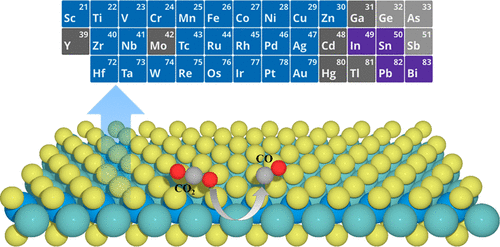当前位置:
X-MOL 学术
›
J. Phys. Chem. C
›
论文详情
Our official English website, www.x-mol.net, welcomes your
feedback! (Note: you will need to create a separate account there.)
Modulating the MoS2 Edge Structures by Doping Transition Metals for Electrocatalytic CO2 Reduction
The Journal of Physical Chemistry C ( IF 3.3 ) Pub Date : 2020-04-20 , DOI: 10.1021/acs.jpcc.0c01070 Xinnan Mao 1 , Lu Wang 1 , Yafeng Xu 1 , Youyong Li 1
The Journal of Physical Chemistry C ( IF 3.3 ) Pub Date : 2020-04-20 , DOI: 10.1021/acs.jpcc.0c01070 Xinnan Mao 1 , Lu Wang 1 , Yafeng Xu 1 , Youyong Li 1
Affiliation

|
Two-dimensional transition metal dichalcogenides (TMDs) nanomaterials, such as MoS2 and WSe2, have proved to be promising electrocatalysts for CO2 reduction, in which the reduction product is CO with high selectivity. In order to improve the sluggish CO desorption process and the overall electrocatalytic performance, we have extensively explored the optimal dopants in MoS2 by high-throughput density functional theory (DFT) calculations and demonstrated the enhanced electrocatalytic activity. The dopants of V, Zr, and Hf into MoS2 could significantly promote the desorption of CO from the MoS2 edge, achieving the optimal performance for electrocatalytic CO2 reduction. Furthermore, the dopants locating close to the active Mo site is crucial to influence the catalytic activity, while the dopant concentration is not important. The modulating strategy we proposed here also applies to other TMDs materials for enhancing electrocatalytic activity.
中文翻译:

通过掺杂过渡金属调制MoS 2边缘结构以实现电催化CO 2还原
二维过渡金属二硫化碳(TMDs)纳米材料,例如MoS 2和WSe 2,已被证明是用于CO 2还原的有前途的电催化剂,其中还原产物是具有高选择性的CO。为了改善缓慢的CO脱附过程和整体电催化性能,我们通过高通量密度泛函理论(DFT)计算广泛地探索了MoS 2中的最佳掺杂剂,并证明了其增强的电催化活性。V,Zr和Hf掺入MoS 2可以显着促进CO从MoS 2边缘解吸,从而实现电催化CO 2的最佳性能减少。此外,靠近活性Mo位点的掺杂剂对于影响催化活性至关重要,而掺杂剂浓度并不重要。我们在这里提出的调节策略也适用于其他TMDs材料,以增强电催化活性。
更新日期:2020-04-20
中文翻译:

通过掺杂过渡金属调制MoS 2边缘结构以实现电催化CO 2还原
二维过渡金属二硫化碳(TMDs)纳米材料,例如MoS 2和WSe 2,已被证明是用于CO 2还原的有前途的电催化剂,其中还原产物是具有高选择性的CO。为了改善缓慢的CO脱附过程和整体电催化性能,我们通过高通量密度泛函理论(DFT)计算广泛地探索了MoS 2中的最佳掺杂剂,并证明了其增强的电催化活性。V,Zr和Hf掺入MoS 2可以显着促进CO从MoS 2边缘解吸,从而实现电催化CO 2的最佳性能减少。此外,靠近活性Mo位点的掺杂剂对于影响催化活性至关重要,而掺杂剂浓度并不重要。我们在这里提出的调节策略也适用于其他TMDs材料,以增强电催化活性。































 京公网安备 11010802027423号
京公网安备 11010802027423号